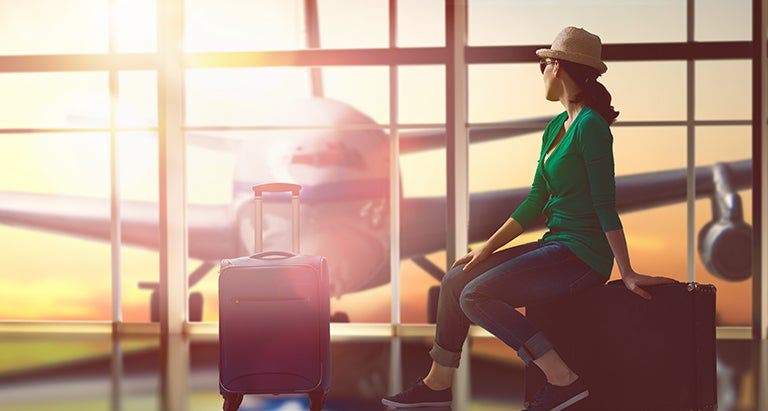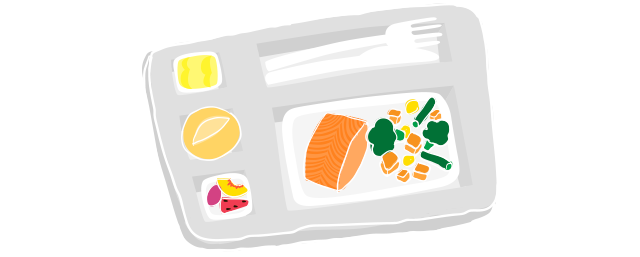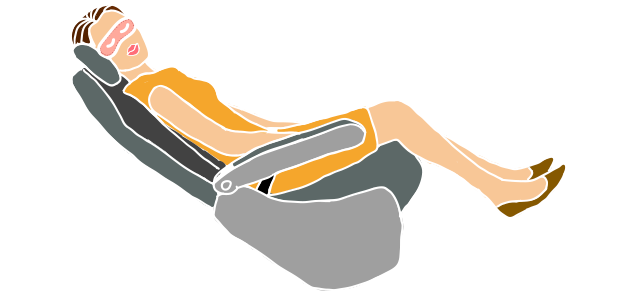5 tips for healthier airplane meals


Flying these days takes a lot of work: you need to wear easy-on, easy-off shoes, make sure your toiletries are packaged properly and get to the gate with at least a half-hour to spare — all of which gets exponentially harder the more people you're traveling with. Worrying about what you'll eat en route can seem like just another hassle you'd rather avoid.
But if you wait until the cabin door is shut and the seatbelt light is on to think about your next meal, you severely limit your odds of finding healthy, tasty fare. Airline cutbacks largely mean no more free meals, and now most flyers are offered overpriced boxes full of pre-packaged goodies. While there are sometimes a few healthier options up for grabs (as long as the flight attendant gets to your row before supplies sell out) it can be tempting to eat everything in the box.
Save your money and your waistline. The folks who publish the Shape Up America! newsletter analyzed one major airline's box and found it contained more than 1,000 calories with minimal nutritional value. The mini-meals that some airlines offer are no better: they're often high in fat and sodium but dressed up as innocent-sounding sandwiches. Some of the packaging contains nutritional information, but even if not, you can be pretty sure that a focaccia sandwich is going to pack quite a punch, fat-wise.
"People get into food situations where they think, 'Woe is me, guess I have to eat whatever they give me,'" says Hope Warshaw, a Washington, DC-area RD and author of What to Eat When You're Eating Out. "But 99 percent of the time, you have options. If you plan ahead just a little bit, you will never have to break your program."

1. Order ahead
If you do find yourself on a rare meal-service flight, most airlines offer alternative menus such as low-cholesterol, vegetarian, etc. that are yours for the eating if you order ahead. Most airlines' Web sites will tell you whether they're serving free meals, and define exactly what they regard "low-calorie" and so on to be. Even the airlines that sell meals should have these alternatives, so it's always worth checking.

2. Pack protein and nuts
Warshaw recently flew to Barcelona with her family and packed whole-wheat turkey wraps for the trip. Bottom line: If you pack your own food, "you have total control over what you eat," she says. Stick with high-protein, high-fiber choices that help make you feel fuller, longer. Almonds, string cheese and apples all travel well in carry-ons, and are permissible at the security line.

3. Pester the flight attendants
For water, that is. A steady supply of water (skip the regular sodas and high-calorie fruit juices) will prevent altitude dehydration and keep you walking up and down the aisle to the bathroom — something you should do on long flights anyway.

4. Take a movie over dinner
Most plane passengers aren't really hungry. "Eating is just something to do," says Warshaw. If you have nothing better to do, you'll eat whatever is put in front of you, even if it's not free. Beat the urge by doing what one frequent business flyer we know does: As soon as the food service cart appears, he opens his laptop and works or watches a movie until everyone's scraps are taken away. There's never any room on his tray table, so he never eats the food.

5. Develop an attitude
If you work hard to maintain a healthy lifestyle and/or lose weight, this discipline and motivation should not change when you reach the airport, says Warshaw. Airline travel is such a controlled march these days — check in here, take your shoes off there, sit upright immediately — that it's easy to get lulled into a passive state. And that, says Warshaw, is what leads people into accepting what's offered to them, like the cold bagel with the full-fat cream cheese. Remind yourself that what you eat and drink is totally your call.
